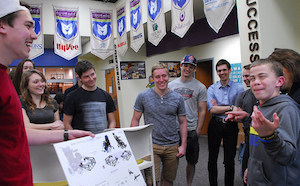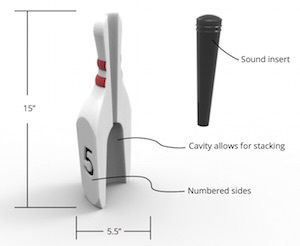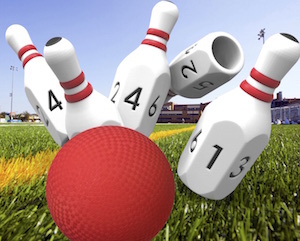Students in Iowa State University's industrial design program create assistive sports equipment for special needs kids. Video by Dave Olson
AMES, Iowa — Industrial design students at Iowa State University are learning to use a tool that will serve them well throughout their careers. It's not a soldering iron, needle nose pliers, glue gun or even a 3-D printer. It's empathy.
This spring, 29 students are designing assistive sports equipment for a recreational facility that serves people with special needs. Courage League Sports in Urbandale — whose motto is "Every Child Deserves to Play" – has teamed up with Iowa State's industrial design department to create the equipment. And several ISU students have gone above and beyond, volunteering at Courage League to better understand the athletes' special needs during sports play.
The students are designing equipment that does not exist anywhere else — from multipurpose bowling pins that give auditory feedback for kids with differing abilities to a universal guard attachment that enables athletes to play power soccer comfortably from their own wheelchairs. This semester, 22 designs (some developed by individuals, some by teams) are being carried through to high fidelity prototypes.
Now in its second year, the collaboration is expanding play opportunities for Courage League participants and learning opportunities for ISU students.
Keeping it real
A leather mitt on a wooden stick — the Courage Mitt — emerged from last year's class. The simple apparatus enables children who are wheelchair bound or have balance issues to field a ball as unrestricted and independently as possible.
"Our kids grow up watching baseball just like every other kid," said Courage League Program Director Molly Wuebker. "It was very important to us that we were able to keep the aesthetic integrity of the sport intact. These kids want — and deserve — to play with a glove that has a more traditional look. The Courage Mitt gives them that opportunity."
Wuebker said Courage League is working with a manufacturer to get the mitt in production for testing and replication.
"That’s the model we want to see going forward," said ISU Industrial Design Professor and Chair David Ringholz. "Our students will generate a product and Courage League will develop it. We're doing their R&D, and they're doing the production."
A whole new ballgame for students
Learning how to design with empathy for specialized populations is an extra asset for the budding designers in Industrial Design Lecturer Mirna Garza-Gonzalez's studio. The course objective is to expose students to real-world issues in the practice of industrial design. It's the first time they've designed for a client.
"That means they learn about meeting the customer's requirements, expectations and needs," Garza-Gonzalez said. "And they have to change their designs accordingly."
“In the past we’ve only presented to the industrial design faculty," said William Huskisson of Oconomowoc, Wisconsin. "It’s an entirely different challenge to work with people outside of our field."
The main difference is the clients' ongoing presence in the design process, said Limay Vong, Waukee. “When we research, ideate, prototype — we constantly get their feedback. It helps us create more meaningful and sustainable products.”
And a real-world project can limit their freedom, said Daniel Gulick of Marion. “But this is not always bad. The client often helps guide the design decisions.”
Feeling it
In the first part of the course, the students focused on learning the terms, methods and principles of designing for specialized populations. They studied physical limitations and assistive devices, gaining an understanding of the differences between assistive, adaptive, barrier free, transgenerational and universal design. And they learned the game regulations and sports devices used at Courage League.
“We discussed how to bring the experience of the game to the players — the feeling of kicking the ball or pitching a ball so they can have the sensation of playing the game,” Garza-Gonzalez said.
"The students are learning how to use listening and observation to get insights from the users, which helps them empathize with someone who is different. They understand the importance of considering what questions to ask their clients and how to not bias the answers. This will help them throughout their whole careers," she said.
“It is really eye opening to see how someone with autism interacts with a product differently from someone in a wheelchair,” Huskisson said.
The game changer
Playing alongside the Courage League athletes on weekends, evenings or during spring break has enhanced the design experience for the students who volunteer. It has enabled them to connect emotionally and design responsively.
“It's humbling to design something that truly matters and can impact someone’s life for the better,” said Colton Westerberg, Forest City.
Ian Baker, Des Moines, volunteers some evenings and for weekend special events. During National Volunteer Week, Courage League recognized Baker for his commitment.
"While volunteering, I try to shut off the designer in me and focus on creating an inviting atmosphere for the participants. I have to approach it with an open mind," Baker said.
"I get to experience the gameplay with them, sit in the wheelchairs and realize what a struggle it is to play basketball or soccer without use of my legs. And I get to do this all outside of the design mindset. I’m there to help out and play," he said.
It's only on the drive back to Ames that Baker reflects — as a designer — on what he saw or experienced that day.
"I think about how a person may have struggled with a certain activity because of the equipment. How could we make this game more inclusive? In what way did someone struggle when doing a task? Where was their attention or interest lost?," he said.
“Volunteering has given me a better feel for who we’re designing for," Baker said. "It’s incredibly difficult and really dishonest to design for people you’ve never been around or observed. Once you're interacting with people, you can truly understand their habits.”
Baker and his teammate Daniel Gulick are designing stackable bowling pins that deliver the sound of pins crashing and crowd cheering when knocked down. And they wanted to create interactive pins that could have multiple uses for a variety of games. Their pins have six sides with numbers (like dice) so they can be used for other games.
The inspiration came from watching the kids play the facility's existing bowling game, some with difficulty. They noticed that each activity is short to keep players interested.
"This would be fun for any kid, but the point is that despite physical and cognitive limitations, anyone can safely and confidently play this bowling game," he said.
Courage League's Wuebker said the collaboration between ISU and Courage League is breaking down barriers and providing more opportunities for the special needs population.
"It has been a game changer for our program and participants, both literally and figuratively," she said.
Plans are in place to continue the collaboration. And Baker said he would "absolutely stay involved this summer."
"This project really opened my eyes as a designer. I've realized how inclusive design doesn't just benefit specific populations. It benefits us all."


